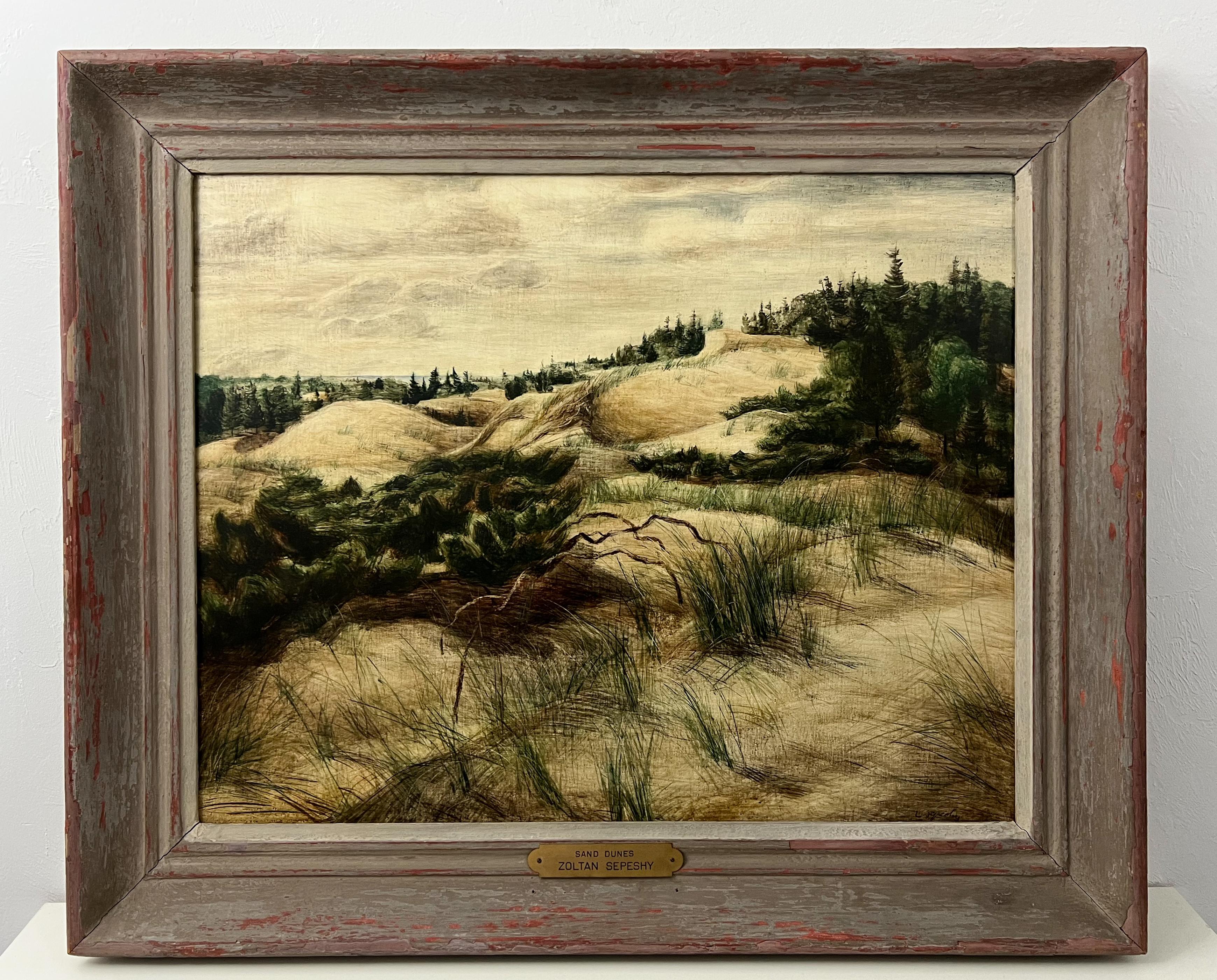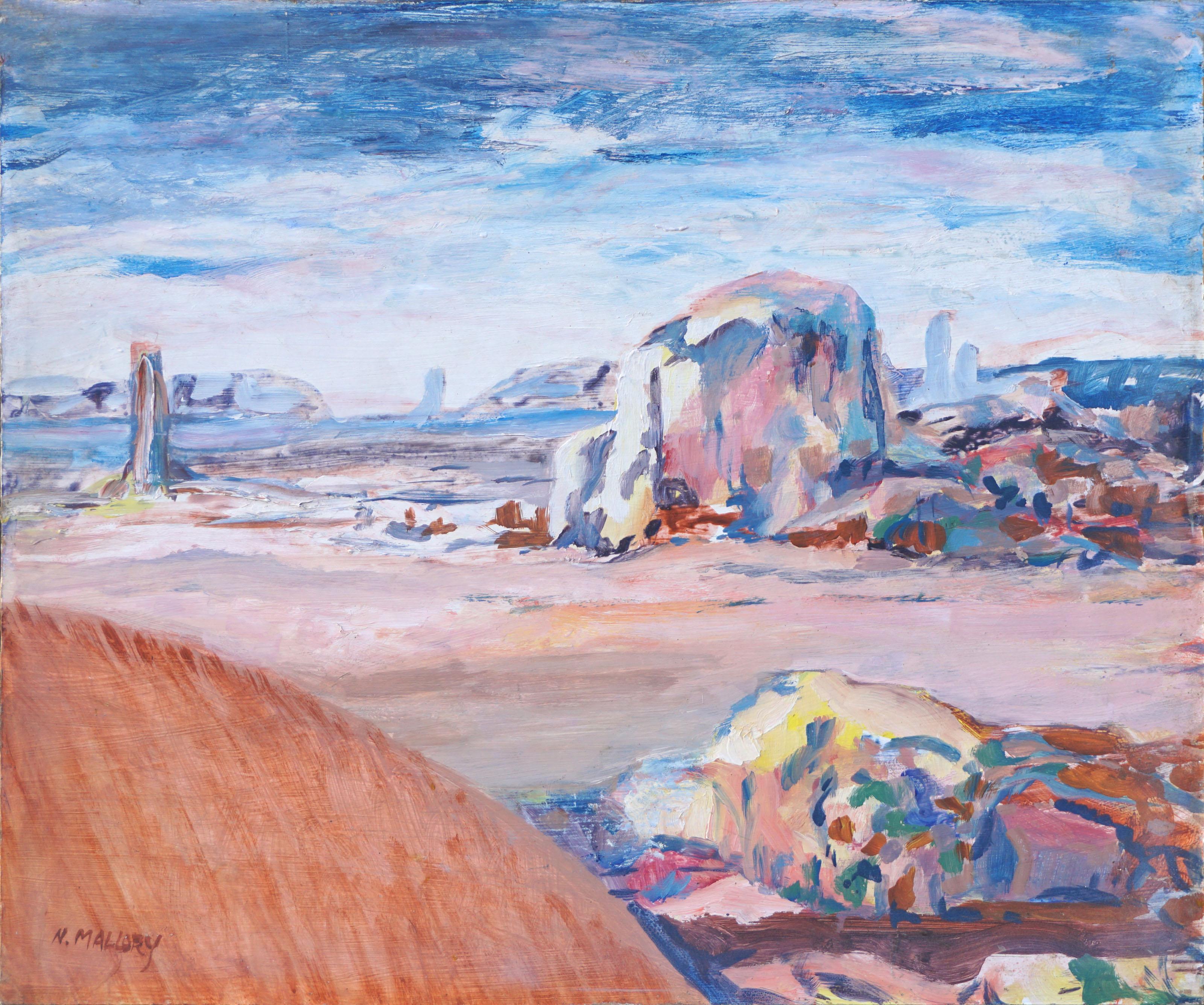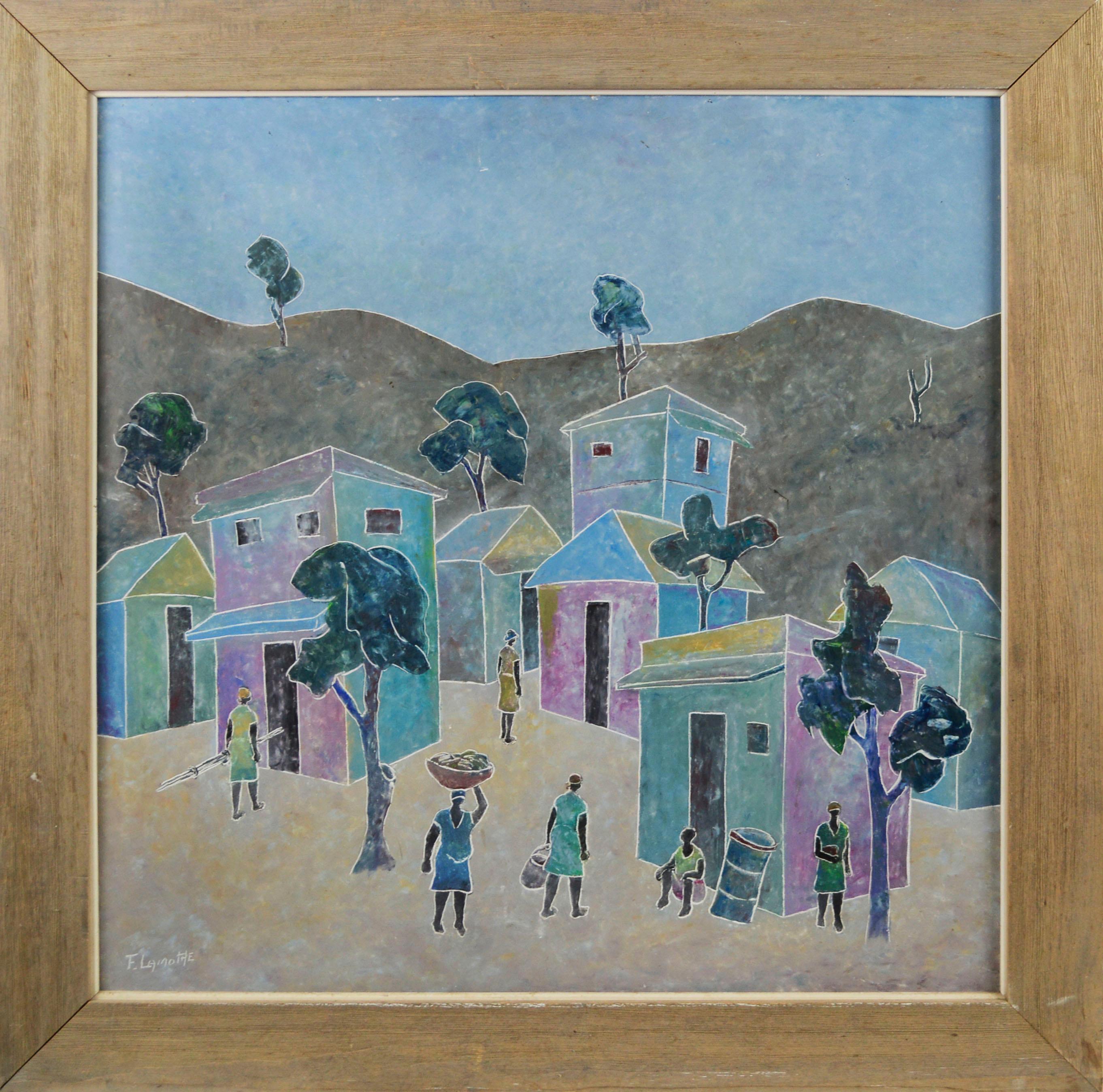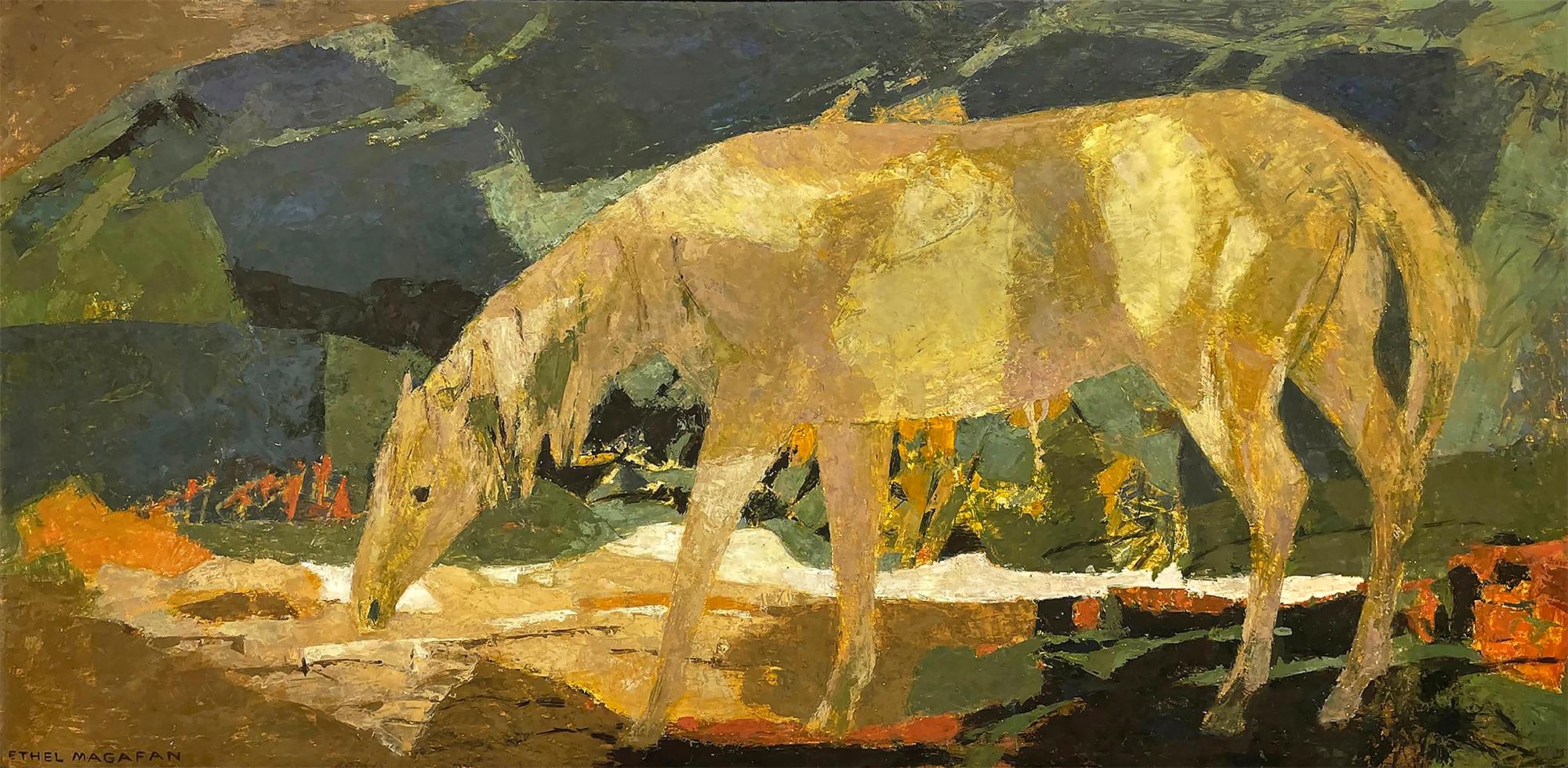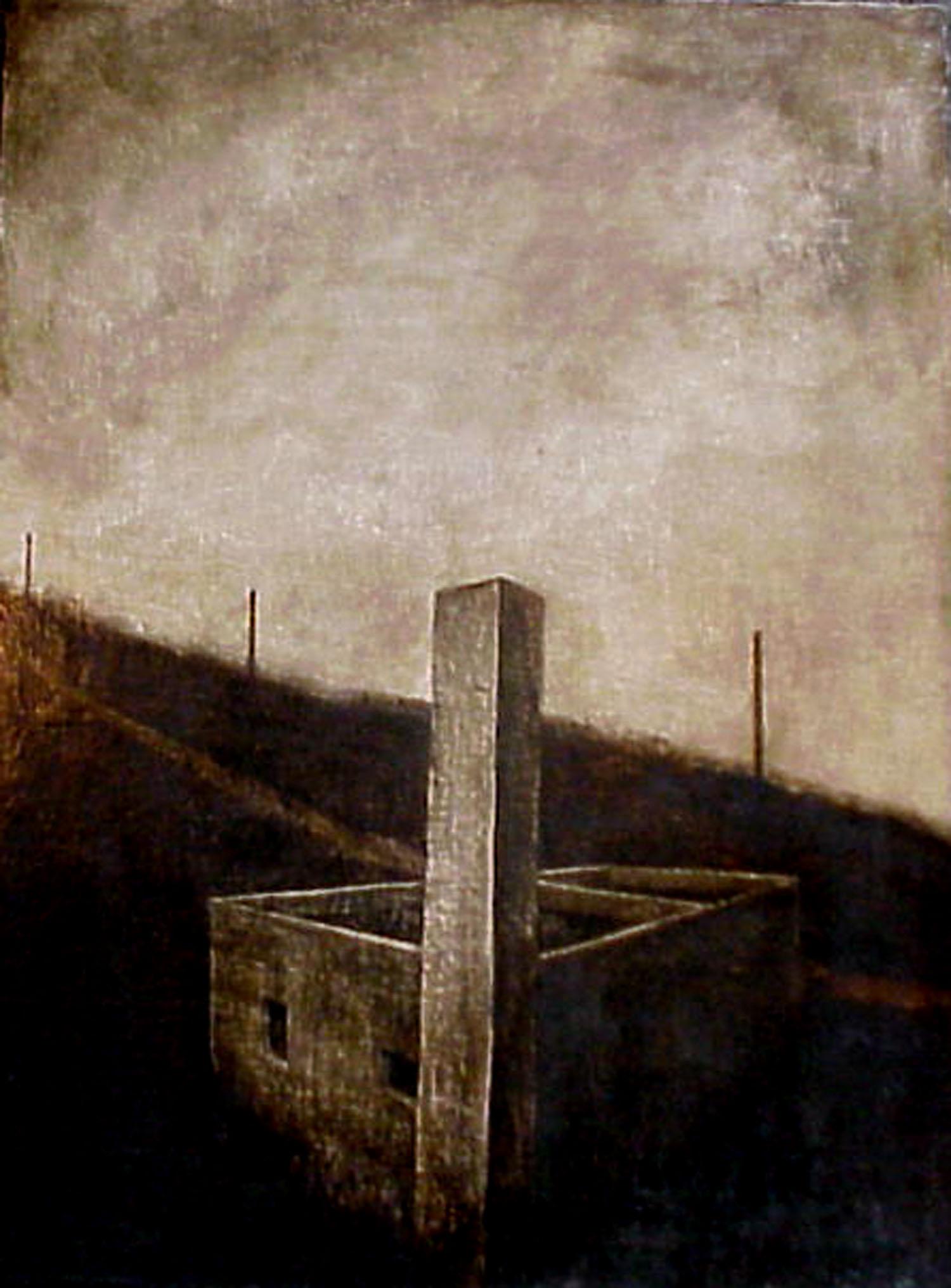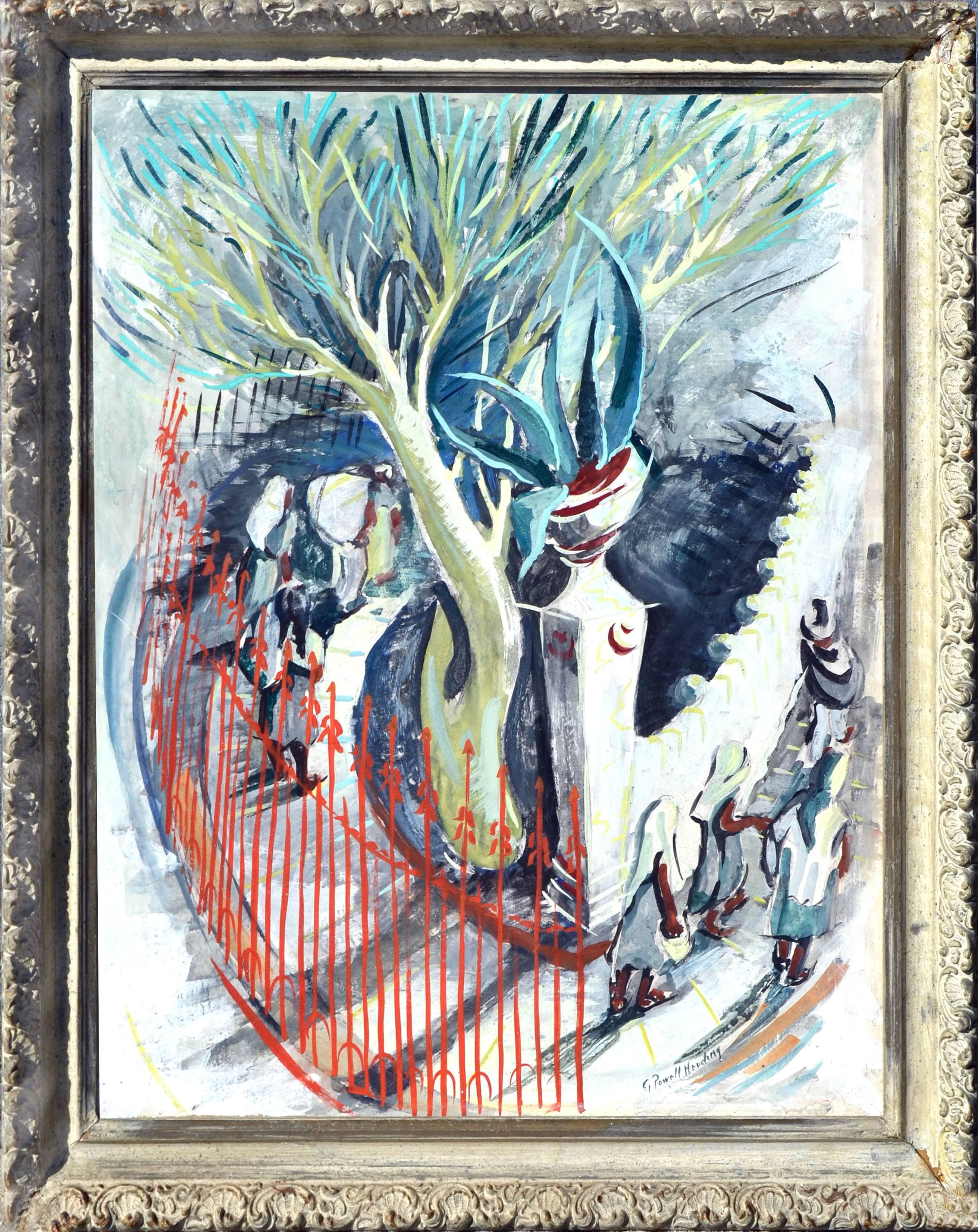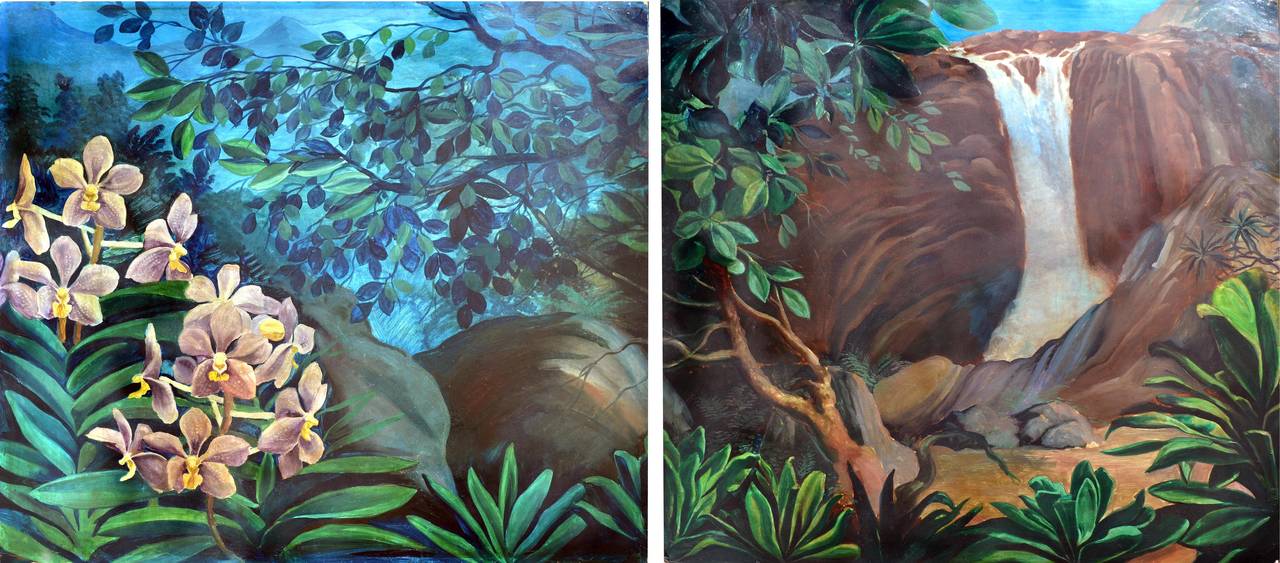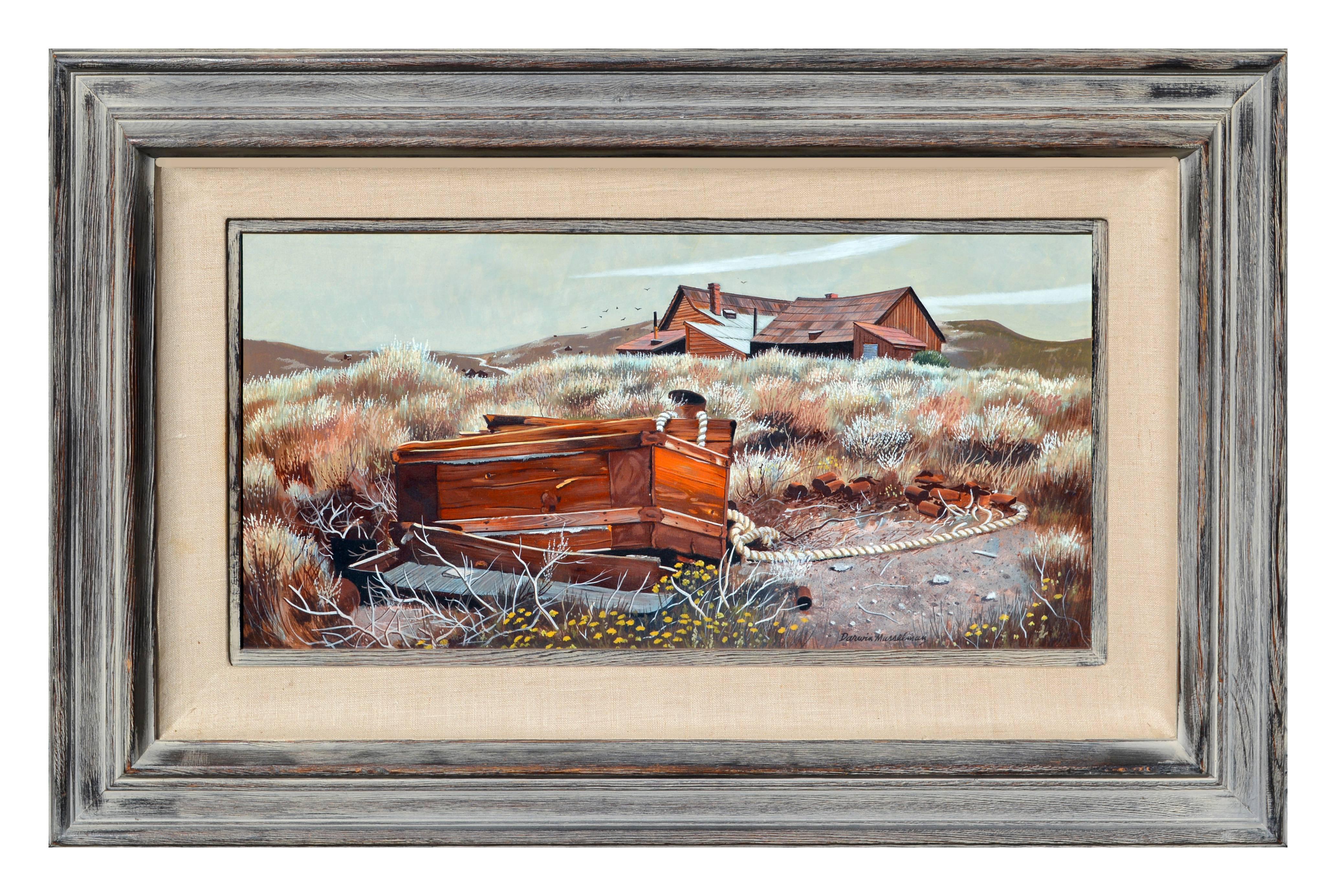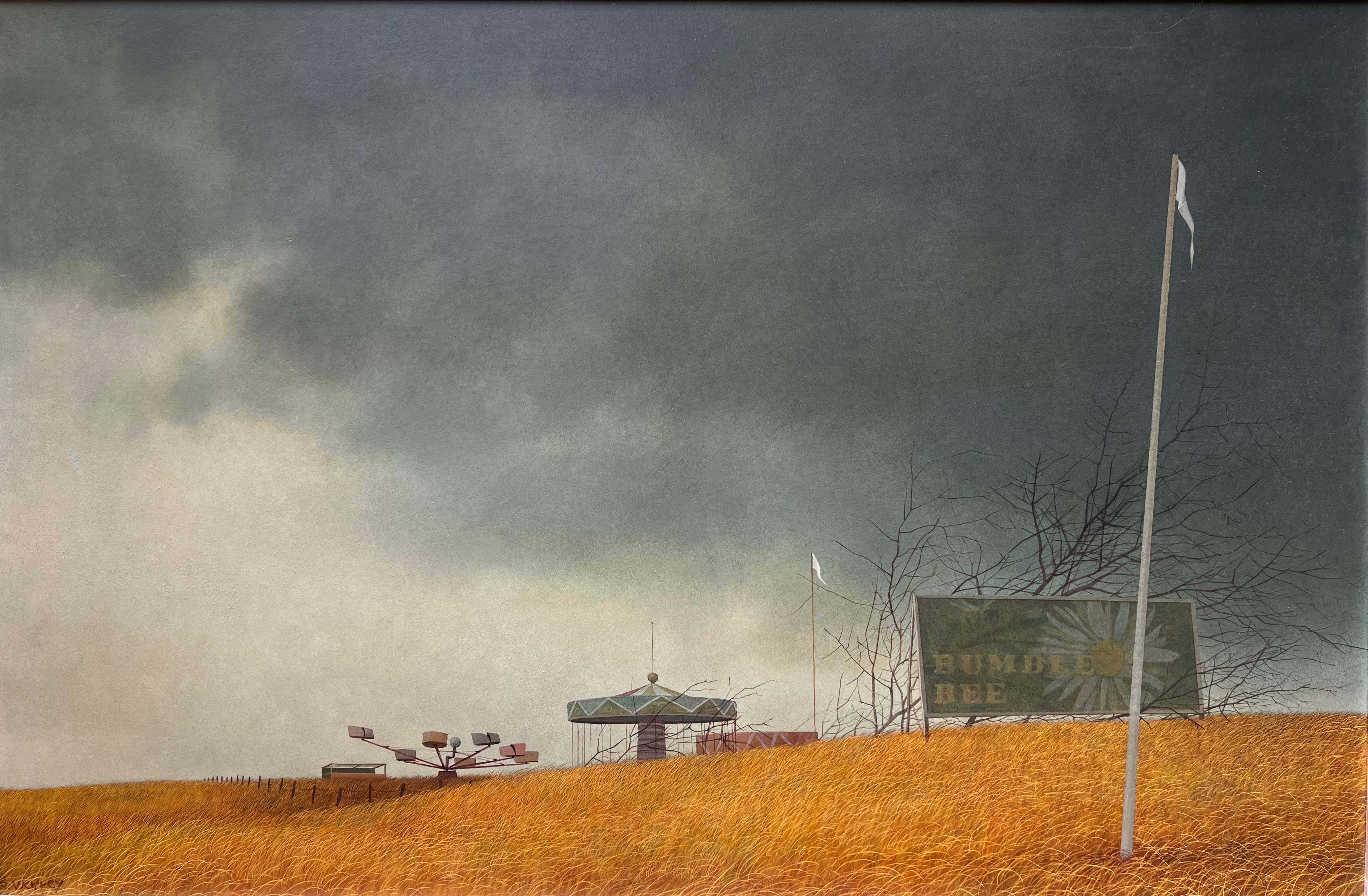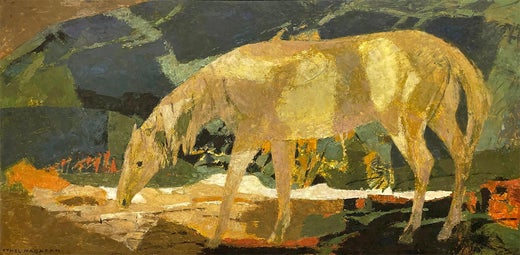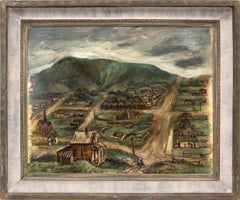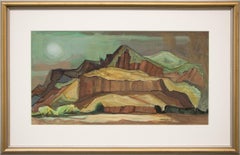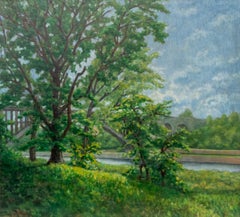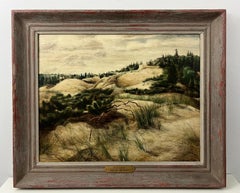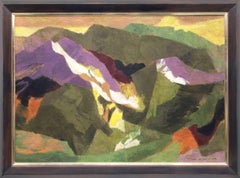
Above the Desert (Colorado)
View Similar Items
Want more images or videos?
Request additional images or videos from the seller
1 of 10
Ethel MagafanAbove the Desert (Colorado)circa 1950
circa 1950
$12,500List Price
About the Item
- Creator:Ethel Magafan (1916-1993, American)
- Creation Year:circa 1950
- Dimensions:Height: 33.75 in (85.73 cm)Width: 45.5 in (115.57 cm)Depth: 1.5 in (3.81 cm)
- Medium:
- Period:
- Condition:
- Gallery Location:Denver, CO
- Reference Number:Seller: 136311stDibs: LU273182912
Ethel Magafan
Ethel Magafan Born Illinois, 1916
Died New York, 1993 Jenne and Ethel Magafan were identical twins, born in Chicago to a Greek immigrant father and a Polish mother. Due to health concerns about their father, the family moved to Colorado, living first in Colorado Springs and then in Denver. He was a proud supporter of their artistic ambitions but died suddenly 1932, a heavy blow to both of them. They attended East High School in Denver, where they found a mentor in their art teacher Helen Perry. She had studied at the Art Institute of Chicago but had later abandoned a career as an artist, making her all the more determined to help the Magafan twins succeed artistically. While still in high school, the twins impressed artist Frank Mechau, and Helen Perry paid for their lessons with him. He subsequently invited them to apprentice with him at his Redstone studio. In 1936, Jenne won the Carter Memorial Art Scholarship and shared it with her sister so that they both could attend the Broadmoor Art Academy in Colorado Springs. Once they ran out of money, Mechau, now teaching there, hired them as assistants. Through their involvement at the Academy, the twins entered into careers as muralists, working at first with Mechau and then with Peppino Mangravite. From 1937 to 1943, Ethel was commissioned to paint her first of seven government sponsored murals. Located in the US Post Office in Auburn, Nebraska, this commission made Ethel (at age 26) the youngest artist in America to receive such an honor. Denver Art Museum director Donald J. Bear once commented that “[Ethel and Jenne's] study of local detail makes them appear as little Bruegels of ranch genre – natural and unforced.” As mural painting commissions diminished, Ethel began to do more easel painting for which she used a palette knife and tempera paints to great effect. After settling in California for five years, the twins permanently relocated to Woodstock, New York in 1945, where the sisters lived apart for the first time. Ethel developed an increasing focus within her work, particularly for horses and abstract landscapes. She met fellow artist Bruce Currie at an artist’s party, and the two were married in 1946. The twins and their husbands went to Greece and Italy for a year when Jenne’s husband and Ethel were granted Fulbright Scholarships. Upon their return, Jenne died suddenly of a cerebral hemorrhage — a loss that Ethel would mourn deeply. With her sister gone, her landscapes became much more abstract, as she sought out the feeling of the scene rather than an exact representation. During the mid-fifties, she began to make annual trips to Colorado. Her stature within the art world was solidified in 1971 when the United States ©David Cook Galleries, LLC
About the Seller
5.0
Gold Seller
Premium sellers maintaining a 4.3+ rating and 24-hour response times
Established in 1979
1stDibs seller since 2013
290 sales on 1stDibs
Typical response time: 13 hours
Authenticity Guarantee
In the unlikely event there’s an issue with an item’s authenticity, contact us within 1 year for a full refund. DetailsMoney-Back Guarantee
If your item is not as described, is damaged in transit, or does not arrive, contact us within 7 days for a full refund. Details24-Hour Cancellation
You have a 24-hour grace period in which to reconsider your purchase, with no questions asked.Vetted Professional Sellers
Our world-class sellers must adhere to strict standards for service and quality, maintaining the integrity of our listings.Price-Match Guarantee
If you find that a seller listed the same item for a lower price elsewhere, we’ll match it.Trusted Global Delivery
Our best-in-class carrier network provides specialized shipping options worldwide, including custom delivery.More From This Seller
View AllMartyl Schweig 1942 Oil Painting, Victor, Colorado, Ghost Town Landscape
By Martyl Suzanne Schweig Langsdorf
Located in Denver, CO
This stunning original 1942 oil painting, titled "Victor, Colorado", is by acclaimed American artist Martyl Suzanne Schweig (1918–2013). A vibrant and historically rich landscape, this work captures the abandoned ghost town of Victor, Colorado, set against the majestic backdrop of the Rocky Mountains. Rendered in rich hues of green, gold, and earthy brown, Schweig brings to life the rugged beauty and quiet mystery of Colorado’s once-booming mining towns.
The painting was completed during a plein-air painting trip with noted artist Adolph Dehn...
Category
1940s American Modern Landscape Paintings
Materials
Oil, Masonite
"Spring Storm" 1980s Modernist Southwestern New Mexico Landscape Casein Painting
By Doel Reed
Located in Denver, CO
Spring Storm is an original vintage painting by renowned New Mexico and Oklahoma modernist Doel Reed (1894-1985). This captivating piece, painted in June 1980, depicts a dramatic Sou...
Category
1980s American Modern Landscape Paintings
Materials
Casein
$9,200 Sale Price
36% Off
1941 Autumn Landscape of Pikes Peak by Charles Bunnell, American Impressionist
By Charles Ragland Bunnell
Located in Denver, CO
941 Egg Tempera Landscape of Pikes Peak by Charles Bunnell – Autumn in Colorado
This original 1941 egg tempera painting by celebrated Colorado artist Charles Bunnell (1897–1968) bea...
Category
1930s American Impressionist Landscape Paintings
Materials
Tempera
John E. Thompson 'High Bridge, NYC' Signed Oil Painting, American, 1924
By John Edward Thompson
Located in Denver, CO
This original 1924 oil painting by acclaimed Colorado modernist John E. Thompson captures the architectural grandeur of High Bridge, New York City’s oldest standing bridge, as it spans the Harlem River. A powerful blend of realism and early modernist style, the composition highlights the bridge’s elegant arches and structural detail, all rendered in richly textured oil on canvas.
Thompson’s masterful brushwork and use of color breathe life into the urban landscape, creating a dynamic visual tribute to one of NYC’s most iconic 19th-century engineering feats. The painting is signed and dated in the lower right corner, adding historical authenticity and collector appeal. It is housed in a custom vintage frame, complementing the period and enhancing its timeless aesthetic.
This rare depiction of early 20th-century New York City is an important work for collectors of vintage American art, urban landscapes, and historical landmarks. It bridges two artistic worlds—urban realism and the advent of modernism—making it a standout piece in any serious collection.
About the Artist: John E. Thompson – Pioneer of Colorado Modernism
John Edward Thompson (1876–1945) is widely regarded as the "Dean of Colorado Artists", known for his pivotal role in introducing European modernist techniques to the American West. Born in Buffalo, Thompson studied at the Art Students League of Buffalo and later in New York City, before immersing himself in Europe’s avant-garde movements, particularly influenced by Paul Cézanne.
In 1914, Thompson settled in Denver, where he would become a transformative force in the local art scene. His teachings and leadership helped lay the foundation for Colorado’s modern art movement, and he later served as a faculty member at both the University of Denver and the Santa Fe Art School, alongside contemporaries like Andrew Dasburg, B.J.O. Nordfeldt, and Walter Ufer.
Thompson also mentored key figures such as Józef Bakoś and Walter Mruk, who would go on to co-found Los Cinco Pintores...
Category
1920s American Impressionist Landscape Paintings
Materials
Oil
Colorado Mountain Landscape with River, 1890s Watercolor Painting
By Charles Partridge Adams
Located in Denver, CO
This original late 19th-century watercolor painting beautifully captures a classic Colorado mountain landscape by iconic early 20th century artist, Charles Partridge Adams. The compo...
Category
1980s American Impressionist Landscape Paintings
Materials
Watercolor
East Santa Cruz Landscape: Yellow Farmhouse with Storm Clouds Oil Painting
By Jon Blanchette
Located in Denver, CO
East Santa Cruz (California) is a striking original oil painting on canvas board by noted California artist Jon Blanchette (1908–1987). This evocative landscape features a bright yellow farmhouse set against a backdrop of dramatic dark gray storm clouds, capturing the natural beauty and emotional contrast of the California coast. Blanchette’s expert use of light and color creates a compelling sense of both tranquility and approaching tension.
Painted in the mid-20th century, this work reflects Blanchette’s signature romantic realism and deep connection to the California landscape. The painting is presented in a custom frame using archival materials. Framed dimensions: 21 ¾ x 25 ¾ x 1 ½ inches, image size: 16 x 20 inches
About the Artist:
Born in England, Blanchette studied at the Pittsburgh Art...
Category
1950s American Modern Figurative Paintings
Materials
Oil
You May Also Like
The Cavern 1950 painting by John Atherton
Located in Hudson, NY
Signed lower right: "Atherton", inscribed "John Atherton Original Tempera 7/28/50" on verso.
Artwork measures 16" x 20" and framed 20" x 24" x 2 ½"
About this artists: John Atherton (1900-1952) did not show an early aptitude for art; rather, his first love was nature and the activities he relished there, mainly fishing and hunting. Born in Brainerd, Minnesota in 1900, he learned to fish with his father from the age of four. Later the family moved to Spokane, Washington, and when he was old enough, Atherton worked at a variety of jobs to help support his family. One such job, in the sorting plant of a lead and silver mine, paid $4.25 a day—a good wage, though he never had time to spend his money, since he worked seven days a week.
After serving in the Navy for a year during World War I, Atherton was determined to get an education. He worked as a sign painter and played the banjo in a dance band, finally accumulating enough money to enroll in the California School of Fine Arts in San Francisco. Once there, he worked like a fiend, attending classes both during the day and at night, getting the best training available.
Though he had always intended to be a fine artist, Atherton’s first jobs were for commercial art firms. In 1929, using the prize money won for a painting he entered in an art competition, Atherton and his wife moved to New York City. Though the economic situation was difficult in those years, he managed to keep going by taking commissions for magazine illustrations, and over the years he would paint more than forty covers for The Saturday Evening Post.
In 1938, an artist friend suggested that he use the same flat, decorative style as his commercial work for his gallery paintings. This was a breakthrough for Atherton; soon afterwards he held a one-man show at the Julien Levy Gallery in New York, and his paintings began to be collected by museums including the Museum of Modern Art in New York and the Metropolitan Museum of Art.
Atherton’s reputation increased to a national scale when he designed the art deco stone lithograph poster for the 1939 World’s Fair that strikingly depicted Earth and its atmospheric layers in the lap of Liberty.
Atherton was highly influenced by the magic realist...
Category
1950s Modern Paintings
Materials
Masonite, Tempera
Sandscape- Mid-Century Tempera Painting of Michigan Coastal Sand Dunes Landscape
Located in Marco Island, FL
This is an important, large tempera painting of the sand dunes that line Michigan's coast. Zolton Sepeshy, who lived and painted in Michigan, also wrote a book on tempera painting. ...
Category
Mid-20th Century American Realist Landscape Paintings
Materials
Masonite, Tempera
Olin Dows Surrealist Tempera Painting.
By Olin Dows
Located in Phoenix, AZ
Olin Dows Surrealist Subject Painting. Signed lower left and dated 1965.
The work is in excellent condition and is unframed tempera on masonite.
It measures 10 1/4"h x 13 1/2"w. This...
Category
1960s Landscape Paintings
Materials
Masonite, Tempera
Building Backyard, Painting by Joan Nelson
By Joan Nelson
Located in Long Island City, NY
This painting by Joan Nelson depicts a sepia-toned scene placed behind the walls of a dark brown building. Potentially depicting a rooftop or a balcony, a way further into the buildi...
Category
1980s Contemporary Landscape Paintings
Materials
Plaster, Masonite, Egg Tempera
Monument Valley Landscape, Utah
Located in Soquel, CA
Vivid abstracted landscape of Monument Valley, Utah by N. Mallory (American, 20th Century), circa 1945. Signed lower left corner. Condition: Good: Some edge and corner wear consisten...
Category
1940s American Impressionist Landscape Paintings
Materials
Masonite, Tempera
Haitian Village Figurative Landscape
Located in Soquel, CA
A gorgeous tempura painting of figures carrying goods and taking a break in a Haitian village by Frantz (Freddie) Lamothe (Haitian, b.1961). Signed "F. L...
Category
Mid-20th Century Abstract Impressionist Figurative Paintings
Materials
Masonite, Tempera
Recently Viewed
View AllMore Ways To Browse
David Cook Gallery
Flemish 16th Century Painting
Harrison And Son
Mark Bryan
Mary Jones Painting
Anthony Springer
Impressionist Farm Barn Painting
John F Kennedy Painting
Red Horn Italian
California Poppy
Florida Antique Landscape
Highland Cattle
Jan Michaels
Marine Sailing Ships
Painting 19th Century Sailing Ship
Painting Cabin Woods
Paintings From Newlyn School
T Robinson Painting
